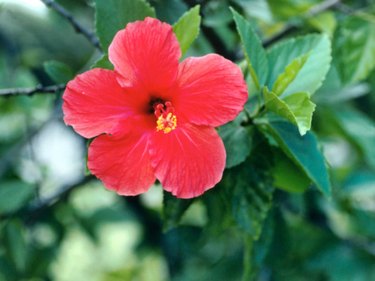
Tropical hibiscus plants are often kept as potted plants outside of their normal USDA hardiness zones (4 to 9), so that they can be brought indoors to survive harsh winters. This limited growing space often results in problems such as improper watering or lack of nutrients, which can cause the leaves to droop. Whether indoors or out, improper care is the main cause of wilting leaves in hibiscus plants.
Water
Video of the Day
Lack of water is an obvious cause of wilting in many plants, including hibiscus. If the soil is completely dry, hydrate the plant and give it time to return to normal. On the other hand, too much water can also cause wilting in a hibiscus plant. Standing water can cause roots to rot, which will make the leaves droop. The right amount of water depends on the weather. During warm weather, make sure the soil does not dry out completely. When the soil just below the surface is only slightly damp, it's time to water again. During winter months, hibiscus need less water. Let the soil become almost dry, so that there is only a little moisture when you insert a finger 1 inch into the soil, before providing more water.
Video of the Day
Soil and Nutrients
Hibiscus are not picky about the type of soil they are planted in, as long as it is well-drained. In heavy soils that do not drain well, hibiscus can begin to show signs of stress, such as wilting or drooping leaves. Lack of proper nutrients can also cause leaves to droop on a hibiscus plant. This is most common in alkaline soils where the soil composition prevents hibiscus from absorbing iron. Fertilize regularly, feeding the hibiscus in early spring, late spring, mid-summer and late fall or early winter. For alkaline soils, use a fertilizer with chelated iron so that the plant can absorb it.
Light
Potted hibiscus that are kept outdoors during the summer and brought inside during the winter often have drooping or wilting leaves after a month or two indoors. This is usually due to lack of light. Outdoor plants can experience the same problem if they are kept or planted in the shade. Move the plants to a sunnier location or use grow lights indoors to provide the hibiscus plant with at least 13 hours of light per day. Outdoors, prune back trees to provide more light or transplant the hibiscus to a sunnier location.
Wilt
Wilt, especially verticillium wilt, is a disease that attacks hibiscus and causes the entire plant to wilt. It will usually show up in the leaves first and they will begin to droop and turn yellow. There is no simple treatment for wilt, but it can be managed by pruning away infected parts of the plant and keeping the hibiscus as healthy as possible by meeting its water, fertilization and sunlight needs.